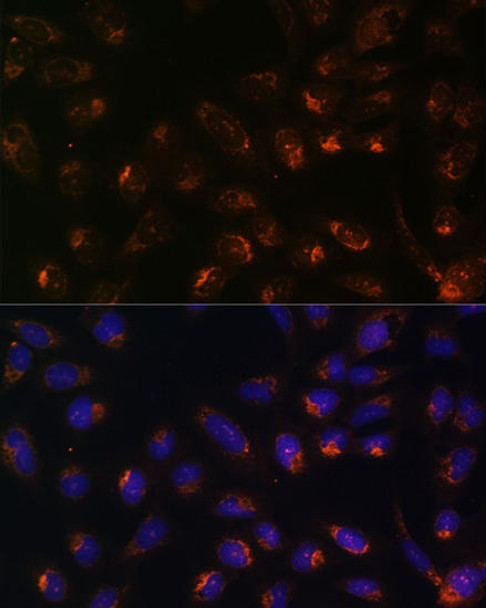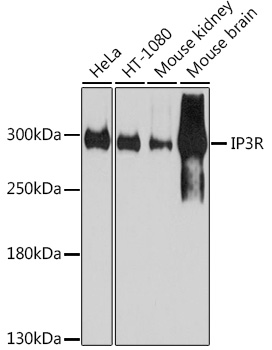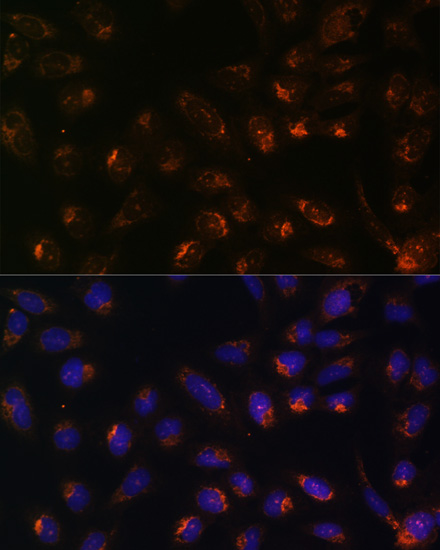Anti-IP3R Antibody (CAB7905)
- SKU:
- CAB7905
- Product type:
- Antibody
- Reactivity:
- Human
- Mouse
- Rat
- Host Species:
- Rabbit
- Isotype:
- IgG
- Antibody Type:
- Polyclonal Antibody
- Research Area:
- Cell Death
Description
| Antibody Name: | Anti-IP3R Antibody |
| Antibody SKU: | CAB7905 |
| Antibody Size: | 20uL, 50uL, 100uL |
| Application: | WB IHC IF IP |
| Reactivity: | Human, Mouse, Rat |
| Host Species: | Rabbit |
| Immunogen: | A synthetic peptide corresponding to a sequence within amino acids 1850-1950 of human IP3R (XP_011531985.1). |
| Application: | WB IHC IF IP |
| Recommended Dilution: | WB 1:500 - 1:2000 IHC 1:50 - 1:200 IF 1:50 - 1:100 IP 1:50 - 1:200 |
| Reactivity: | Human, Mouse, Rat |
| Positive Samples: | HeLa, HT-1080, Mouse kidney, Mouse brain |
| Immunogen: | A synthetic peptide corresponding to a sequence within amino acids 1850-1950 of human IP3R (XP_011531985.1). |
| Purification Method: | Affinity purification |
| Storage Buffer: | Store at -20°C. Avoid freeze / thaw cycles. Buffer: PBS with 0.02% sodium azide, 50% glycerol, pH7.3. |
| Isotype: | IgG |
| Sequence: | SFFC RLTE DKKS EKFF KVFY DRMK VAQQ EIKA TVTV NTSD LGNK KKDD EVDR DAPS RKKA KEPT TQIT EEVR DQLL EASA ATRK AFTT FRRE ADPD DHYQ P |
| Gene ID: | 3708 |
| Uniprot: | Q14643 |
| Cellular Location: | Endoplasmic reticulum membrane, Multi-pass membrane protein |
| Calculated MW: | 306-313kDa |
| Observed MW: | 315kDa |
| Synonyms: | ITPR1, ACV, CLA4, INSP3R1, IP3R, IP3R1, PPP1R94, SCA15, SCA16, SCA29 |
| Background: | This gene encodes an intracellular receptor for inositol 1, 4, 5-trisphosphate. Upon stimulation by inositol 1, 4, 5-trisphosphate, this receptor mediates calcium release from the endoplasmic reticulum. Mutations in this gene cause spinocerebellar ataxia type 15, a disease associated with an heterogeneous group of cerebellar disorders. Multiple transcript variants have been identified for this gene. |
| UniProt Protein Function: | IP3R1: a multi-pass endoplasmic reticulum membrane receptor for inositol 1,4,5-trisphosphate, a second messenger that mediates the release of intracellular calcium. Plays a role in ER stress-induced apoptosis. Cytoplasmic calcium released from the ER triggers apoptosis by the activation of CaMKII, eventually leading to the activation of downstream apoptosis pathways. Part of a cGMP kinase signaling complex that includes alpha-actin, calponin H1, phospholamban, PKG1 and IP3R1. Widely expressed. The receptor contains a calcium channel in its C-terminal extremity. Its large N-terminal cytoplasmic region has the ligand-binding site in the N-terminus and modulatory sites in the middle portion immediately upstream of the channel region. Phosphorylation by PKA prevents the ligand-induced opening of the calcium channels. Belongs to the ryanodine-inositol 1,4,5-triphosphate receptor ca(2+) channel (rir-cac) family. Eight alternatively spliced isoforms have been described. |
| UniProt Protein Details: | Protein type:Channel, ligand-gated; Channel, calcium; Membrane protein, multi-pass; Membrane protein, integral Chromosomal Location of Human Ortholog: 3p26.1 Cellular Component: calcineurin complex; endoplasmic reticulum; endoplasmic reticulum membrane; integral to membrane; membrane; nuclear inner membrane; nucleolus; platelet dense granule membrane; postsynaptic density; sarcoplasmic reticulum Molecular Function:calcium channel inhibitor activity; calcium ion transmembrane transporter activity; inositol 1,4,5-triphosphate-sensitive calcium-release channel activity; intracellular ligand-gated calcium channel activity; phosphoinositide binding; protein binding Biological Process: blood coagulation; calcium ion transport; endoplasmic reticulum calcium ion homeostasis; energy reserve metabolic process; epidermal growth factor receptor signaling pathway; epithelial fluid transport; fibroblast growth factor receptor signaling pathway; innate immune response; inositol phosphate-mediated signaling; negative regulation of calcium-mediated signaling; nerve growth factor receptor signaling pathway; phospholipase C activation; platelet activation; post-embryonic development; regulation of insulin secretion; release of sequestered calcium ion into cytosol; response to hypoxia; signal transduction; stimulatory C-type lectin receptor signaling pathway; vascular endothelial growth factor receptor signaling pathway; voluntary musculoskeletal movement |
| NCBI Summary: | This gene encodes an intracellular receptor for inositol 1,4,5-trisphosphate. Upon stimulation by inositol 1,4,5-trisphosphate, this receptor mediates calcium release from the endoplasmic reticulum. Mutations in this gene cause spinocerebellar ataxia type 15, a disease associated with an heterogeneous group of cerebellar disorders. Multiple transcript variants have been identified for this gene. [provided by RefSeq, Nov 2009] |
| UniProt Code: | Q14643 |
| NCBI GenInfo Identifier: | 519668682 |
| NCBI Gene ID: | 3708 |
| NCBI Accession: | Q14643.3 |
| UniProt Secondary Accession: | Q14643,Q14660, Q99897, E7EPX7, E9PDE9, |
| UniProt Related Accession: | Q14643 |
| Molecular Weight: | |
| NCBI Full Name: | Inositol 1,4,5-trisphosphate receptor type 1 |
| NCBI Synonym Full Names: | inositol 1,4,5-trisphosphate receptor type 1 |
| NCBI Official Symbol: | ITPR1 |
| NCBI Official Synonym Symbols: | ACV; CLA4; IP3R; IP3R1; SCA15; SCA16; SCA29; INSP3R1; PPP1R94 |
| NCBI Protein Information: | inositol 1,4,5-trisphosphate receptor type 1 |
| UniProt Protein Name: | Inositol 1,4,5-trisphosphate receptor type 1 |
| UniProt Synonym Protein Names: | IP3 receptor isoform 1; IP3R 1; InsP3R1; Type 1 inositol 1,4,5-trisphosphate receptor; Type 1 InsP3 receptor |
| Protein Family: | Inositol 1,4,5-trisphosphate receptor |
| UniProt Gene Name: | ITPR1 |
| UniProt Entry Name: | ITPR1_HUMAN |









